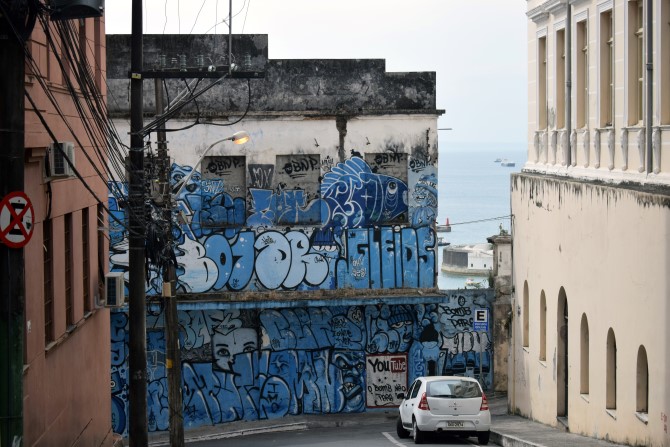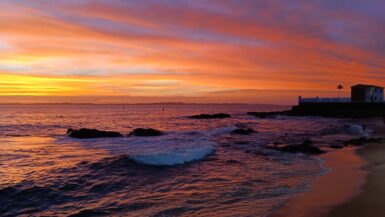Surprisingly, on Monday morning, Salvador didn’t wake up with a hangover. Either Brazilians can really hold their liquor, either the alcohol content in Skol beer is close to zero—Feng and I peered at a can to find out but the label didn’t mention it as if, like everything in Brazil, it goes without saying that locals know instinctively the alcohol content they ingest.
The only two Carnival-related activities going on were fixing the protective boards panels around buildings, sticking posters on them and cleaning up the city. The latter was mostly accomplished by the dozens of little hands from the favelas who were picking up cans to sell them to buyers of recyclable materials.
The Skol sellers would apparently be camping in their designated spot for the entire Carnival. Most were asleep on the sidewalk, behind their yellow Styrofoam cooler.
Okay, pré-Carnival was taking a break and clearly, so were stores because it didn’t look like they had restocked since the previous Friday.
That’s fine. Salvador isn’t just famous for its carnival, it’s also one of the oldest colonial cities in the Americas. There are plenty of places to explore—or none if you believe you’re going to get killed as soon as you leave the hotel.
An hour’s walk uphill from Barra—this isn’t an estimate, I’ve been going up and down all week—is the Pelourinho district of the upper town, home to many examples of Portuguese colonial architecture and historical monuments and a World Heritage Site.
The first thing you see coming from Barra is the Praça Municipal with the letreiro com o nome de Salvador—when did cities over the world decide to install giant city-name letters on popular public squares? Where does this trend come from?
On Praça Municipal, you can take the Elevador Lacerda, Brazil’s first elevator, connecting cidade alta and cidade baixa since 1873. The elevator is the easiest way and quickest way (22 seconds!) to go up or down 72 metres between the Thomé de Souza Square in the upper city, and the Cayru Square in the lower city, and also, you’re really not supposed to walk the streets between the two anyway.
But the main attraction in Pelourinho is the Convento e Igreja de São Francisco, built between 1708 and 1723. I had heard it kept sporadic opening hours so I wasn’t planning to visit it but I wanted to see it, so we started looking for the church, presumably the main tourist attraction.
After ten minutes in Pelourinho, two things became clear. First, if you’re ever going to set a meeting place in the area, don’t say, “by the old church.” Pelourinho is 40% historical monuments, 10% souvenir shops and 50% old churches. Second, there were more vendors than tourists around, which I found strange since this is Salvador’s must-see neighbourhood.
The city must have expected dumb dollar-loaded camera-wearing tourists as well because half of Salvador’s police forces was hanging out… I mean, protecting Pelourinho. This was apparently best accomplished by sipping coconut water.
We went up and down the cobblestone-paved streets looking for Igreja de São Francisco. Nope, not that one… not that one either. This one? Nope. After an hour, we had no idea where we were and where the famous church was, plus I had seen enough Jesus for a lifetime—yes, Mark, he’s dead.
Eventually, we came back to Largo do Pelourinho and suddenly, I was offered two clues. First, there was a car with an Argentinian licence plate parked nearby. Second, a kind soul walking by said, “the church is open!” Foreigners… an open church… It must be it!
Here it was, right in front of us—the first church we saw when we arrived, except we had no idea it was the church because old churches kind of all look… well, old and possibly famous.
“It’s open, we’re lucky! Let’s go!”
And this is how for only 5 reais (the other not-as-famous church next door charged 15 reais!) we stepped into Salvador’s most famous church. I understood why right away. All surfaces inside—walls, pillars, vaults and ceilings—are covered by golden sculpted gilt woodwork and paintings. Blue-white tile panels, by Bartolomeu Antunes de Jesus and imported from Lisbon, cover the lower parts of the walls of the main chapel and transept and depict scenes of the life of St Francis of Assisi. So it is an igreja dourada (golden church), it just doesn’t show from the outside!














































is “church” = igreja in Portugese? similar to my language, “gereja
Yes 🙂 Funny, is your language based on Spanish or Portuguese?
probabaly Portuguese for few words. Before Dutch and/or VOC came, history said Portuguese landed first in Eastern Indonesia. Most of the people over there are Christian. Nice! I just knew it where the initial word came!
In Spanish, it’s iglesia, so there’s definitely a common root somewhere 🙂 What’s the name if your language?
That outdoor elevator blows my mind. It’s not something you see in the U.S. It’s fun reading your stories and seeing your photos.
I’m thinking of traveling to South America for the first time. Will probably look back at your blog posts for inspiration on where to go!
Do it! DO IT! And please, ask away. I know most countries but Paraguay, the Guyana, Venezuela and Colombia. Based on your French “background”, I think you’d like Argentina.
Thanks! I appreciate it. I probably would like Argentina but it wouldn’t be my first stop (though it could be my second!) because I’d like to go somewhere less European after having traveled so much in France.
Ah, that makes sense. Then I’d suggest Peru and the Inca world!
[…] I played They Don’t Care About Us. The video was shot in Pelourinho, so Mark remembered the drums and the streets and went to get his Olodum t-shirt we bought in […]